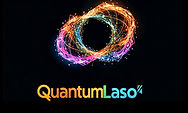QuantumCURE: Measuring the True Power of Randomnes
- mansour ansari

- Oct 10
- 2 min read
By Mansour Ansari – QuantumLaso, LLC

In drug discovery, randomness isn’t noise — it’s a force of creation. Today, I’m proud to share a major leap forward in quantum-enhanced molecular simulation: the new Quantum Lab Proof Page in QuantumCURE, where pseudo-random (PRNG) and quantum-random (QRNG) seeded docking runs can now be compared side-by-side on real compounds.
For the first time, researchers — or citizen scientists — can visualize how the origin of entropy changes binding affinities across proteins and molecular weight classes.Each simulation exports full SDF and JSON data for PyMOL, enabling structural verification at atomic resolution.

In a recent test using EGFR (Lung Cancer) and BCR-ABL (Leukemia) targets, the system revealed striking differences:
Some runs favored PRNG with stronger local binding,
Others showed QRNG exploring deeper energy wells,
Quantum seeding consistently broadened conformational diversity, especially in larger ligands (>1000 Da).
This marks a new era where entropy becomes measurable — no longer invisible.
Here is a partial section of the JSON ready for Pymol visualization:

{
"comparison_batch_id": "4a39180e-7db2-4612-928c-105e693fb62e",
"target_protein": "BCR-ABL",
"mw_bin": "750-850",
"compound_count": 9,
"summary_statistics": {
"median_delta_affinity": -1.113725490196079,
"qrng_wins": 9,
"prng_wins": 0,
"ties": 0
},
"compounds": [
{
"compound_id": "2245",
"smiles": "CC(=O)Oc1ccccc1C(=O)O",
"name": "CID-2245",
"prng_affinity": -4.856501960784313,
"qrng_affinity": -5.970227450980392,
"delta_affinity": -1.113725490196079,
"prng_clusters": 1,
"qrng_clusters": 1,
"winner": "qrng"
},
{
"compound_id": "2519",
"smiles": "Cn1cnc2c1c(=O)n(C)c(=O)n2C",
"name": "CID-2519",
"prng_affinity": -4.996801960784314,
"qrng_affinity": -6.110527450980393,
"delta_affinity": -1.113725490196079,
"prng_clusters": 1,
"qrng_clusters": 1,
"winner": "qrng"
},🔬 What Comes Next: The Skala Validation Layer
Beginning in 2026 (or sooner), QuantumCURE will integrate Microsoft’s Skala, a deep-learning-based exchange-correlation functional for Density Functional Theory (DFT) calculations, available via Azure AI Foundry.Skala brings experimental-level quantum accuracy to compound verification, confirming binding energies, electron distributions, and stability before synthesis.
In practical terms:
The Wet List you see today becomes tomorrow’s Skala-verified Wet List — each candidate molecule advancing from computational prospect to quantum-confirmed reality.
With this, QuantumCURE will become one of the world’s first citizen-accessible DFT-grade validation systems, blending:
Entropy (QRNG, D-Wave, IonQ) → exploration
AI (CURE Engine) → prioritization
Skala (Microsoft DFT) → final verification
A full discovery-to-validation loop — all born in Oklahoma City, from one engineer’s vision to global quantum science.
💡 QuantumCURE continues to grow as a bridge between AI, quantum computing, and drug discovery — turning randomness into a tool for healing.Follow the progress at CitizenScientist.org and QuantumLaso.com.
==================================================================================




Comments